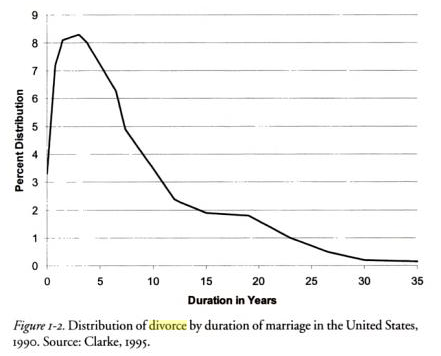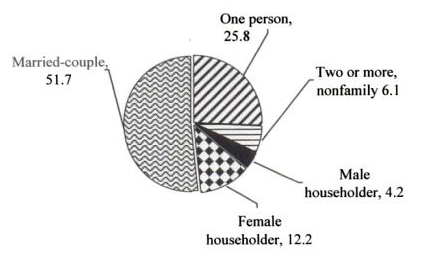Divorce data
From page 18 of this book, Divorce: causes and consequences. The book also mentions a 2002 CDC report which found that after three years, 12 % of all marriages had ended in divorce or separation; after 5 years, 20 % of all first-marriages had ended, after 10 years; 33 %. After 15 years the number is 43 %. Maybe there’s such a thing as a ‘7-year-itch’, but the divorce likelihood is statistically much higher in the years before that and divorce risk in general is highly front-loaded. If 20 % of all marriages have ended in divorce after 5 years and the likelihood that a marriage will end in divorce after 50 years is 50%, that means that 40 % of all divorces that do happen (…at least within a 50 year time frame) take place during the first 5 years of marriage. In the US, first marriages that end in divorce last about eight years [on average].
US divorce patterns might not be similar to those found other places, so it makes sense to add some data from the UK (same link): “According to [a 2004] survey, husbands engaged in extramarital affairs in 75% of cases; wives in 25%. In cases of family strain, wives’ families were the primary source of strain in 78%, compared to 22% of husbands’ families. Emotional and physical abuse were more evenly split, with wives affected in 60% and husbands in 40% of cases. In 70% of workaholism-related divorces it was husbands who were the cause, and in 30%, wives. The 2004 survey found that 93% of divorce cases were petitioned by wives, very few of which were contested. 53% of divorces were of marriages that had lasted 10 to 15 years, with 40% ending after 5 to 10 years. The first 5 years are relatively divorce-free, and if a marriage survives more than 20 years it is unlikely to end in divorce.”
As should be clear from the above passages, divorce patterns are not the same across countries. In the US, people are more likely to divorce early on, whereas the Brits tend to wait longer before they split up. CDC probably has more US data here if Plamus or Gwern (or others?) are interested in taking a closer look, but I didn’t find what I was looking for and I didn’t want to spend a lot of time searching for that data.
If people marry young, the likelihood of divorce is much higher than if they do not. Here’s another graph from the book (p.36):
This link between age and divorce risk is not controversial, the wikipedia link has more:
“Success in marriage has been associated with higher education and higher age. 81% of college graduates, over 26 years of age, who wed in the 1980s, were still married 20 years later. 65% of college graduates under 26 who married in the 1980s, were still married 20 years later. 49% of high school graduates under 26 years old who married in the 1980s, were still married 20 years later.[28]” […] In 2009, 2.9% of adults 35–39 without a college degree were divorced, compared with 1.6% with a college education.[30]”
The book notes (p.40) that: “Interracial marriages are more likely to disrupt than marriages in which both spouses are the same race and ethnicity.[36] Interracial marriages have a 10 percent higher chance of failure in the first 10 years than same-race marriages (41 percent versus 31 percent).”
Here’s another interesting tidbit from the wikipedia article:
“According to a study published in the American Law and Economics Review, women currently file slightly more than two-thirds of divorce cases in the United States.[67] There is some variation among states, and the numbers have also varied over time, with about 60% of filings by women in most of the 19th century, and over 70% by women in some states just after no-fault divorce was introduced, according to the paper. Evidence is given that among college-educated couples, the percentages of divorces initiated by women is approximately 90%.” [my emphasis – again, from the wikipedia link above. This 90% estimate is comparable to the British estimate above and maybe I should have emphasized that one as well. Anyway, it seems that females are much more likely to file for divorce than are males, and it seems that they are pretty much almost always the ones to file for divorce when both partners have a high education level. There’s needless to say more than one model of marriage dynamics that fits those facts, but in order to get a good model, you probably need to include in such a model the fact that males are on average much more likely to cheat on their partner than are females.]
The figure below (the book, p.32) on household data is somewhat unrelated to the above, but worth posting:
Part iii of this previous post of mine has some related Danish household data. Danish readers might also want to reread this post if they want to know more about some related Danish numbers. Right now I’m considering having a closer look at Statistics Denmark’s data on marriage/divorce-patterns – I know they have data on this stuff – so I might write another post on this subject at a later point in time.
No comments yet.



Leave a comment